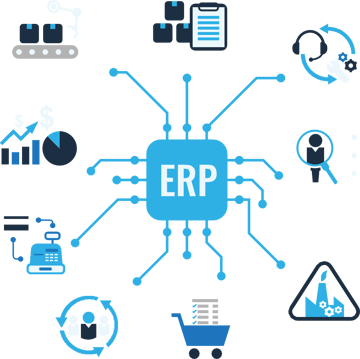Streamline Operations, Boost Efficiency and Achieve Long-Term Success with the Right ERP Solution
Choosing the right Enterprise Resource Planning (ERP) system is crucial for modern business operations. A well-implemented ERP can enhance productivity and profitability, while a poorly chosen one can lead to inefficiency. This blog outlines a 5-step roadmap to help you select an ERP system that aligns with your business goals.

What is an ERP?
An ERP system integrates and manages business-critical data across all departments, providing real-time information sharing and process automation. Modern ERPs include functional areas such as finance, distribution, HR, manufacturing, service management and sales & marketing. They offer a unified database and common interface, improving coordination and decision-making.

Step 1: Create a Vision
- Define Business Challenges: Identify specific challenges your business faces. Consider areas where processes are slow, information is fragmented or real-time insights are lacking. Employee feedback can provide valuable insights.
- Establish Long-Term Objectives: Articulate your long-term goals and how an ERP system can support them, considering areas like growth, innovation and customer focus.
- Align with Technology Strategy: Ensure the ERP fits within your existing technology landscape and supports future scalability. Consider integration, scalability and deployment models.
Step 2: Define Selection Criteria
- Functional Requirements: Outline the functionalities your business needs. Ensure the ERP includes core modules like financial management and CRM and consider any specialised capabilities required by your industry.
- Technical Requirements: Identify technical needs such as integration with existing tools, scalability and security features.
- User Experience: Evaluate the ERP’s usability, including an intuitive interface, role-based access and quality training and support.
- Stakeholder Involvement: Engage stakeholders from executive leadership, operational teams and IT to ensure the ERP meets strategic and practical needs.

Step 3: Establish a Budget
- Initial Budget Formulation: Estimate initial costs, including software licenses, implementation, hardware and training.
- Be Prepared to Adjust: Allow flexibility in your budget for new requirements or technologies.
- Allow for Contingencies: Include a contingency fund for unforeseen costs.
- Long-Term Costs: Consider ongoing costs like maintenance, support and training.

Step 4: Perform the Selection
- Technology Platform: Choose between on-premise, cloud-based, or hosted solutions based on control, cost and scalability needs.
- Evaluate ERP Applications: Select the appropriate tier for your business’s size and complexity.
- Vendor Capabilities: Assess the vendor’s experience, support quality, and ability to customise and integrate the ERP.
- Check References and Reviews: Research customer experiences to identify potential challenges and success factors.
- Consider Third-Party Additions: Explore third-party software to enhance ERP functionality and ensure integration with existing systems.
Step 5: Commit to the Process
- Executive Commitment: Secure leadership support for resource allocation and conflict resolution.
- Define the Process: Create a clear roadmap with milestones, timelines and key stakeholders.
- Assemble a Project Team: Include experienced individuals from across the organisation.
- Establish Realistic Timeframes: Allow flexibility for unexpected delays or changes.
- Emphasise Change Management: Develop a plan for managing resistance and ensuring effective communication, including comprehensive training programs.
- Provide Training and Support: Invest in tailored training and ongoing support to address questions and issues post-implementation.
Selecting the right ERP system involves careful planning and consideration. By following these five steps—creating a vision, defining criteria, establishing a budget, performing the selection and committing to the process—you can choose an ERP that aligns with your business objectives, enhancing productivity and supporting long-term growth. Proper planning, stakeholder engagement and a focus on user experience will make your ERP system a valuable asset, fostering innovation and operational efficiency.

Partner with Cloud Factory for ERP Success
Cloud Factory is your trusted ERP specialist, dedicated to helping businesses successfully implement leading ERP systems such as MYOB Advanced, SAP Business One, Microsoft Dynamics 365, Microsoft Dynamics 365 Business Central, Wiise, PowerPlatform and Korber K.Motion Warehouse Edge.
With a long-standing reputation in the industry, our expert consulting team is focused on guiding you through the entire ERP journey—from initial review to seamless implementation and ongoing support.
At Cloud Factory, we don't just deliver software; we provide tailored solutions that align with your unique business needs.
Contact us or book a free assessement to discover how Cloud Factory can help you achieve ERP success and take your business to new heights.



